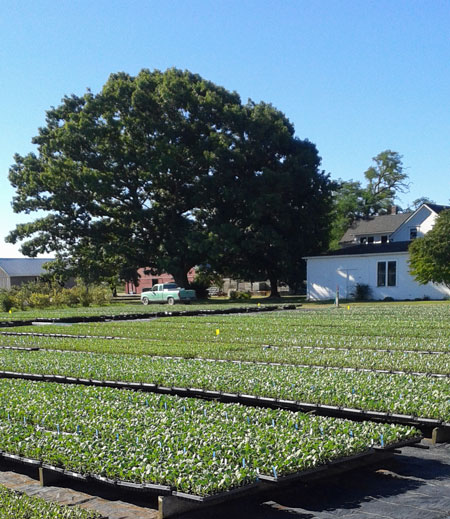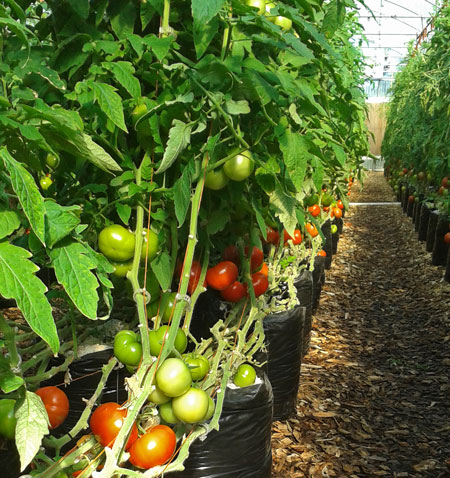We went to two farms. The first was Hedlin's Family Farm, near La Conner. The farm has been owned by the Hedlin family for more than a hundred years. Dave Hedlin, a third generation farmer, told us that his grandfather immigrated from Denmark, and started the farm in 1906. The grandfather was originally a shoemaker. He started the farm by growing oats, which Dave said were very lucrative at that time, because they were that era's diesel fuel: oats powered the horses and horses powered the machines back then. After the First World War, the farmers expanded their crops to include fruits and vegetables, and eventually to seed production. The farm grew from the original 60 acres to more than 500 today.
Fourth-generation farmer Ky took us on a walking tour of the original farm. Their farm supplies more than 80 CSAs (Community Supported Agriculture farm basket shares - click here to read more about those), six farmers markets, and several restaurants and co-ops, in addition to having their own roadside farm stand and selling to wholesalers. Their practices are primarily organic. For example, they practice crop rotation (three years of grass alternating with three years of vegetables) and in the grass years, they trade the grass with a local cattle farmer who supplies them with manure to further enrich the soil. They are working on GAP certification (Good Agricultural Practices, a USDA certification and inspection program) but have not yet completed the paperwork (there's a lot of paper required, according to Ky).

Seed production is now a big part of their business model. Ky said that the Skagit Valley is renowned for seed production, and that they and other farmers have contracts with some of the big-name seed production companies like Syngenta. The photo above shows some flats of cabbage starts that they are growing for the seed company. The company gives them seeds; they don't grow their own. Ky explained that this lets the seed companies have full control of their seed production. The seed company even enforces which farms grow which seeds, and how close different varieties can be grown to each other (so that they can avoid cross-pollination).
The Hedlins grow a lot of wheat (Norwest 553 hard red) and barley. They also collaborate with Washington State University in growing small batches of different varieties of grain, in a project to breed varieties that will grow well in the Skagit climate. This cooperative work benefits both the farm and the school both short term (trade of soil and labor for grain income) and long term (emergence of hardier, more valuable grains).
Hedlin Farm has several huge greenhouses, where they grow "spray free" tomatoes and peppers. Pests are controlled mainly by using insects, though I also saw pheromone traps. The tomato greenhouse below had some small wasps for aphid control, and bumblebees to pollinate.

You can see some other sustainable practices at work in the greenhouse photo: deep layers of cedar chips to retain water, and black plastic-wrapped containers to keep the soil warm. Ky said the tomatoes and peppers are not certified organic, because they use some soil fertilizers, but with that exception they are organic.
The farm had two of the biggest compost piles I've ever seen - easily 50 feet long by six feet square. The original farmhouse is still on the property and still in wonderful condition. It survived a flood in 1918 (most of the La Conner area is six feet below sea level). They are about a mile from the Skagit River, and the area is crosshatched with systems of dikes and sloughs. The soil is naturally high in clay and acidic - they have to put a lot of work, manure and compost in it to get the PH up.
The second farm we visited was La Conner Flats, another fourth generation family farm in the Skagit Valley. They run a program called The Veg Trials, which is both a test garden for developing new and better plant varieties, and an outreach "farm to table" program. Seattle Culinary has a one-acre plot at this farm, where students go each week in the summer to work on the plot and learn first-hand about farming. It was near noon by the time we got to this farm and was very hot. I dug weeds and also transplanted some brussels sprouts seedlings. We had lunch and then headed back to Seattle. It was pleasant to be back on the air-conditioned bus - I'm not used to working outside in that much sun! I did not waste my time on the bus, though. I knit half of a dishrag:

Sometimes I miss the Puget Sound area, there was something about the smell of the ocean and lushness that had a strong appeal, but the long gray winter weather about did me in every year.
ReplyDeleteIt is a gray winter here, but on the other hand, not much snow to shovel :)
ReplyDelete